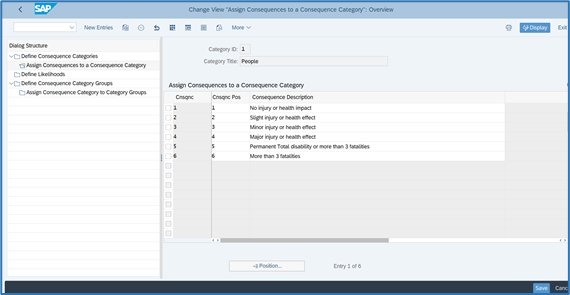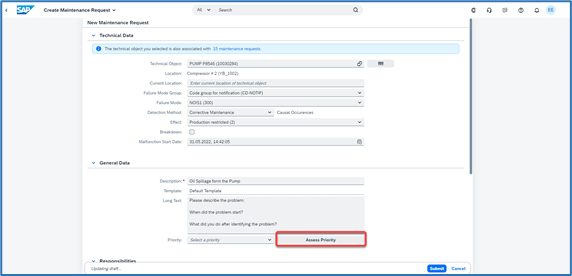
- SAP Community
- Products and Technology
- Enterprise Resource Planning
- ERP Blogs by SAP
- Event Prioritization in SAP S/4HANA Maintenance Ma...
- Subscribe to RSS Feed
- Mark as New
- Mark as Read
- Bookmark
- Subscribe
- Printer Friendly Page
- Report Inappropriate Content
While the selection of a priority can be as simple as selecting from a list of priorities for a notification type, adding more context to why that priority was selected helps planners, reliability engineers, and maintenance supervisors in assessing the criticality of the job. Moreover, having the right tool to assess the priority based on customizable factors helps an organization to achieve these goals.
With SAP S/4HANA Cloud 2011 and SAP S/4HANA 2021 FPS0, the Maintenance Management solution provides a feature for event prioritization which enables you to define consequences and likelihoods to assess priorities for a maintenance request (notification) in a structured and flexible way.
This feature allows you to select consequences and likelihoods in case of the failure of an equipment. While creating or screening a maintenance request, the system calculates and suggests the priority based on consequence categories, consequences, and likelihoods that are selected in the notification and the settings defined in the configuration.
A consequence defines the specific dimension of impact if the failure is not fixed. Likelihood defines the probable occurrence of the selected consequence. This mapping between consequence, likelihood of occurrence, and the calculated priority is configured and assigned to a notification type for a given maintenance plant.
For example, you, as a maintenance technician, observe oil leakage at hydraulic pump HP-1001 in maintenance plant 1010 and want to report this as a malfunction. The event prioritization feature may suggest a very high priority for this maintenance request because the pump is critical for core drilling tasks and, if it is not repaired within two weeks, it could totally damage the asset.
The event prioritization process consists of 3 main dimensions:
- Consequence categories such as environment impact, financial impact, regulatory impact, and safety impact
- Possible consequences for each consequence category
- Possible likelihoods for all consequences
Configuring Consequences and Consequence Categories
A consequence category is a logical grouping of consequences of a similar nature, for example, a consequence category such as 'People- Safety Risk'. You may configure as many consequence categories depending on your business need.
Consequences involve all probable impacts or damages that can be caused in a specific situation, and which may cause risk to the business goal. For example, oil spillage from a pump may not affect the production capacity of a site. However, it may affect the safety of personnel due to a slippery floor, and thus one of the possible consequences could be a 'Major injury or health effect'. Another consequence could be 'No injury or health impact' since the spillage is very less. Similarly, all other possible consequences can be defined and assigned to the consequence category of 'People- Safety Risk'.
In SAP S/4HANA Cloud, you can maintain the predefined consequence categories, consequences, and likelihoods using the configuration activity Define Consequence Categories, Consequences, and Likelihoods

Figure 1 :SSCUI to define Consequences and Categories
In SAP S/4HANA on premise, you can configure consequence categories, consequences, and likelihoods in your configuration environment, by choosing Plant Maintenance and Customer Service > Maintenance and Service Processing > Maintenance and Service Notifications > Notification Processing > Response Time Monitoring > Event Prioritization > Define Consequence Categories, Consequences, and Likelihoods.

Figure 2: Configuration node to define Consequences and Categories
Step 1: Define Consequence Categories
Define categories into which consequences can be grouped.

Figure 3 : Define Consequences Categories
Step 2: Assign Consequences to a Consequence Category
You can assign consequences to a consequence category.

Figure 4 : Assign Consequences to Consequences Categories
Step 3: Define Likelihoods
Define likelihoods to indicate the probable occurrence of a consequence. for e.g., under a situation of heavy oil leakage unattended, “Major injury or health effect” is expected to happen in “2 days to 2 weeks”.
It is recommended that you define all the likelihoods that may be applicable to each consequence

Figure 5 : Define Likelihood
Step 4: Assign Consequence Category to a Category Groups
You can group one or more consequence categories to create consequence category groups. For example, you can create three consequence categories:
- People-safety risk
- Asset-financial risk
- Environment risk
Now, add these three consequence categories to a consequence category group called YEAM01 - Consequence Cat Group

Figure 6 : Assign Consequence Category to a Category Groups
Note: You will be able to assign the consequence category group to a profile and a notification type
Step 5: Maintain Prioritization Profiles
After defining consequences and the likelihoods, you define a prioritization profile. A prioritization profile can be compared to a container that has consequence category groups, notification types, and maintenance plants.
A prioritization profile can be assigned to several maintenance plants, but a maintenance plant cannot have more than one prioritization profile assigned to it. Ensure that you maintain only one prioritization profile for a combination of notification type and maintenance plant.
In SAP S/4HANA Cloud, you can change the predefined content using the configuration activity Define Prioritization Profiles.

Figure 7 : SSCUI for defining Prioritization Profile
In SAP S/4HANA on premise, you can configure prioritization profiles in your configuration environment, by choosing Plant Maintenance and Customer Service > Maintenance and Service Processing > Maintenance and Service Notifications > Notification Processing > Response Time Monitoring > Event Prioritization > Define Prioritization Profiles.

Figure 8 : Configuration node for defining Prioritization Profile
A unique profile ID is assigned to the prioritization profile.

Figure 9 : Define Prioritization Profile 1
You can now configure the prioritization profile by assigning notification types and maintenance plants to the prioritization profile.

Figure 10: Define Prioritization Profile 2
Example:
When you create a maintenance request of notification type Y1 for a technical object that is assigned to the maintenance plant 1010 and assess the priority, the system tries to locate the prioritization profile that matches this combination. Here, the prioritization profile for the combination of notification type Y1 and maintenance plant 1010 is YB-PM00001. The system fetches the priority for the selected combination of consequences and likelihood.
Step 6: Assign Consequence Category Group
After maintaining prioritization profiles, you can assign a consequence category group to a prioritization profile. A prioritization profile can be assigned to only one consequence category group. But you may assign the same consequence category group to one or more prioritization profiles.

Figure 11 : Assign Consequence Category Group
Step 7: Assign UI Positions to Consequences
After assigning a consequence category group to a prioritization profile, you assign a UI position to a consequence category. Within a group, you can choose to arrange the consequence categories in a particular order. When you assess priority, you will see the consequence categories in this order

Figure 12 : Assign UI Positions to Consequences
Step 8: Assign Priorities to Consequences
After assigning a UI position to a consequence category, you can assign a priority to a combination of consequence and a likelihood.
You assign an appropriate priority to all possible combinations of consequences and likelihoods. It is important that the priorities are carefully assigned to the combinations since the priorities directly influence other factors of a maintenance request such as the final due date, required start date, and required end date.

Figure 13 : Assign Priorities to Consequences
This image illustrates the consequence and likelihood matrix.

Figure 14 : Consequence, Likelihood and Priority Matrix
The following diagram depicts the high-level configuration data structure with example values for event prioritization.

Figure 15 : Configuration Data Structure
The Assess Priority button in Create Maintenance Request app (F1511A) or Screen Maintenance Requests app (F4072), allows you to select the consequence and the likelihood for an observed effect. The Assess Priority button will be disabled if the system is unable to find a relevant prioritization profile for a combination of a notification type and a maintenance plant (the maintenance plant is derived from the master data of the technical object).

Figure 16 : Create Maintenance Request
When you choose the Assess Priority button, you can select from all the consequences and likelihoods that are available.

Figure 17 : Assess Priority
At each consequence category level, you can enter the consequence and likelihood as applicable, and based upon the system configuration the priority for the respective consequence category is derived by the system.
Upon pressing the Assess button, the system calculates the overall final priority applicable for this maintenance request. The standard logic used to derive the final priority is to pick the highest priority among all the consequence categories.
In the above example,
- Consequence Category People-Safety Risk = High
- Consequence Category Asset-Financial Risk = Medium
- Consequence Category Environment-Environmental Risk = Medium
Hence, the highest priority among the above 3 consequences categories is 'High', and the same will be updated as final derived priority in the notification.

Figure 18 : Derived Final Priority
Extensibility:
If you wish to derive the final priority not just based upon the highest priority but a different set of criteria to meet your business need, you may do so by implementing custom logic using the Business Add-In (BAdI) Maintenance Event Prioritization (BADI_EVENT_PRIORITIZATION). Use the available importing parameters to specify criteria that determine the priority of a maintenance event.
You must be a registered user to add a comment. If you've already registered, sign in. Otherwise, register and sign in.
-
Artificial Intelligence (AI)
1 -
Business Trends
363 -
Business Trends
29 -
Customer COE Basics and Fundamentals
1 -
Digital Transformation with Cloud ERP (DT)
1 -
Event Information
461 -
Event Information
28 -
Expert Insights
114 -
Expert Insights
189 -
General
1 -
Governance and Organization
1 -
Introduction
1 -
Life at SAP
414 -
Life at SAP
2 -
Product Updates
4,679 -
Product Updates
275 -
Roadmap and Strategy
1 -
Technology Updates
1,499 -
Technology Updates
100
- ACM capabilities in a nutshell - Contracting Part 4 in Enterprise Resource Planning Blogs by SAP
- Maintenance Technician Standard Persona in SAP Service and Asset Manager in Enterprise Resource Planning Blogs by SAP
- SAP Business ByDesign – What’s New 24.05 in Enterprise Resource Planning Blogs by SAP
- SAP Activate Realize and Deploy phase activities in the context of Scaled Agile Framework in Enterprise Resource Planning Blogs by SAP
- Understand Upgrading and Patching Processes of SAP S/4HANA Cloud Public Edition in Enterprise Resource Planning Blogs by SAP
| User | Count |
|---|---|
| 7 | |
| 6 | |
| 5 | |
| 4 | |
| 4 | |
| 4 | |
| 3 | |
| 3 | |
| 3 | |
| 3 |